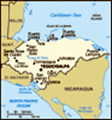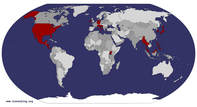Advertisement
Published: March 7th 2005

 Trujillo coastline
Trujillo coastline
View from Bahia BarAlas, I can catch up on my travelblogging...I had actually reverted to the old paper and pen method for awhile since I have been out of cyberland.
My trip to Trujillo was much more than I was ever expecting. It started off quite crummily, as the bus driver lied to me when I asked if it was a direct bus, and I spent 4 and a half hours on a chicken bus with a connection in Tocoa to get to Trujillo....a trip which, on a direct bus, only takes 2 hours. However, I tried to look at the bright side of things, which was that I was the only foreigner on the bus once again, and it proved to be a good Spanish practice experience. All the local people on the bus were so friendly, curious, and just plain nice and helpful. Plus it was raining anyhow, so any plans I had had to spend the afternoon at the beach upon arrival in Trujillo would have been futile for that day.
I was expecting a much larger town than it actually was, and found it to be generally quite quiet by day. Night, however, was a completely different story.
I spent the first night in an almost abandoned restaurant on the beach and made my way back early after the owner of the hotel had warned me that I shouldn't go out alone at night there due to all the drunks. So I was a little paranoid already when I was eating breakfast on the balcony the next morning chatting with a middle-aged Austrian traveler, who told me that he had been robbed on the beach the prior day by two teenagers with a machete. Not that I had doubted the hotel owner's previous advice to take a taxi to the outlying beach areas anyway, but by that point I had scared myself into thinking that I was definitely going to get robbed so I brought the bare minimum with me ... a book, sarong, and cab fare for the ride back ... when I hit the beach. The cab driver too seemed rather alarmed that I was going around northern Honduras by myself, so I started to really doubt what the heck I was doing there, but when I got to Bahia Bar, it was rather empty, but the people who were there were all families with children
and the like, so I felt a little better.
I was immediately approached by "Benjamin", a Garifuna jewelry seller who had just made a few sales to a Honduran family on the beach, and he called me over to play with his exuberant children and check out his wares, all made from coconuts. I told him quite honestly that I had nothing but my cab fare back so I wasn't going to be able to buy anything, but he went on to just keep on chatting anyway. He taught me how to say basic phrases in Garifuna, bought me a beer, and gave me a cool spiky ring out of coconut "for protection." (The Garifuna are descendants of West Africans brought over as slave labor to the West Indies, who intermarried and mixed with the indigenous "Indians" who were already on the islands. They were then transplanted by the British to the Bay Islands of Honduras, where they prospered and grew and eventually also migrated to the north coast of the country. They speak their own language, have their own religion, and their own dance ... the punta.) Soon after he left to take his kids back home to

 Another rooftop view
Another rooftop view
of the greenery and Capiro Calentura national parkTocoa, and I was just blown away by the generosity of this guy.
I laid out on the beach, but I was still afraid to venture into the water for fear that my clothes or something might get stolen, but after awhile I looked up and realized that the beach had slowly filled up and it was quite a safe environment for a swim. The water was absolutely perfect -- clear and warm -- and the view back onto the mainland from the water was terrific. The whole backdrop to the coast is these big hills covered in coconut trees and some other dense green foliage. I can only imagine how beautiful the Mosquitia region of Honduras (just east of Trujillo) is, because all around the town everything is so lush and green and seemingly uninhabited.
Still being the only foreigner on the beach, I guess some of the locals were curious, and pretty soon I had four girls come over to me and sit down and chat with me for about an hour, and then their guy friends came to join them, and they invited me to go out with them that night. As I was thinking, "Wow, maybe I was wrong about this place, because I was about to leave tomorrow on account of security issues, but everyone is so nice!" my notions were reaffirmed by Luciano, the waiter at the bar/restaurant there on the beach, who invited me to eat at the restaurant for free. Hey, I'm a budget traveler....who is going to resist getting a $10 seafood meal for free?? Oh, and I already had thought this upon the first trip to Central America, but now upon the second tasting I have definitely reaffirmed that this seafood soup (sopa marinera) they make up here on the north coast of Honduras is hands down the best thing I have ever tasted. (Competing only with the sopa de caracol with a coconut base that I had the following night.)
That night I went out in town with my new 20 year old protectors and played pool, sat on a beachside bar in the Barrio Cristales and drank this Garifuna drink called Gifuity, which is basically herb and spice-infused rum that you chase with limes and soda water, that is supposed to clear up any congestion or flu like symptoms you may have. I don't know that they actually did anything medicinal for me, but it was a good experience all the same. I was a wee bit nervous when the extremely drunk guy dancing punta with a machete came wobbling over by our table and when there was a domestic dispute in the bar with both husband and wife punching, kicking, and throwing beer bottles at each other until they wrestled each other to the ground and the bystanders pulled them apart..... but hey, not like I haven't seen strange things in bars before in the States.
I got a full workout of my Spanish skills that day/night, as we continued on from the bar to hang out by the dock and then play board games on the roof of my hotel until 1 am or so. So my brain needed a rest the following day and I laid out most of the afternoon and nursed my sandfly bites. (Which unfortunately was just a MINISCULE preview to the sandfly experience at my next destination.) There was a great view from the roof of the hotel over the bay and a good people watching spot as well.
In general I like the low key atmosphere of Trujillo, (although at the disco the following night I was a bit confused by the mix of reggaeton, merengue, George Strait, then Latin rock, then some slow 80s love songs, bachata, then back to reggaeton again) and was duly impressed by the fact that everybody gets along with each other and seems to really appreciate and respect the various cultures that are at play side by side every day. There is a lot of intermarriage anyhow between the Garifuna and the Latinos, so most everyone living there is of a darker color than in the rest of Honduras. On the down side, everyone I met over 20 had at least 2 kids... for the guys I met, they were always with different mothers, and for the girls I met, they were usually raising kids without fathers. But the thing is, everyone seems happy. I was invited into this 28 year old Garifuna lady's house which was far nicer than my own, and reinforced my visual observations that the Honduran people are markedly better off than the Nicaraguans (as a whole....this lady was obviously one of the wealthier citizens of Trujillo).
And as a final cultural note on my tour of this nice Caribbean seaside town, I must add that it is the final resting place of the infamous American bastard, William Walker. For those of you who have traveled in Central America or read a guidebook about it, you have probably heard of him. For those of you who haven't, I can almost guarantee you haven't, so I find it my duty to inform you on what our trusty American history textbooks like to omit from our education. William Walker came from some southern state and apparently thought it his duty to try to take over the world (perhaps a distant ancestor of the Bush family??), so he set sail in 1853 (if memory serves me correctly) to stake his claim on Central American territory. Without getting too technical and messing up all the details, he invaded Costa Rica, Nicaragua, Mexico, and Honduras, each time getting caught and driven out, when he would turn himself over to the US Coast Guard so as to get deported back to the US instead of being tried by the local people. Perhaps the crassest example of the legend of William Walker was in Nicaragua, where he actually succeeded in taking over Granada with his 53 US followers and the backing of the liberals in Leon, where he declared himself president of the country, confiscated Cornelius Vanderbilt's shipping vessels, reinstituted slavery, and took out a loan for personal benefit with the country of Nicaragua as collateral for it. Oh, yes, and the US Government acknowledged him and his government. What the &^%#&^%?? At any rate, on attempt number 4, I believe, to take over Central America, the greedy villain finally met his match in Trujillo, where the less benevolent British authorities who ruled the north of Honduras and Nicaragua did not deport him, but rather turned him over to local authorities, who executed him by firing squad.
The history of bloody and violent US involvement in Latin America makes it all the more shocking and endearing when you, as a US citizen, receive a queen's welcome in such a place as Trujillo. It's a side trip I'll never forget.
Advertisement
Tot: 0.07s; Tpl: 0.012s; cc: 16; qc: 25; dbt: 0.0428s; 1; m:domysql w:travelblog (10.17.0.13); sld: 1;
; mem: 1.1mb












Adam
non-member comment
Hello from Trujillo
I am a Peace Corps volunteer doing my service in Trujillo... stumbled upon your webpage and really delighted in reading about your experience while visiting. It's always interesting for me to compare my experience(s) in Trujillo with those of others who have come through. I'm glad you were able to find the beauty of Trujillo (not that its hard to see since it's literally surrounding you on all sides) despite its sometimes "rougher" edges. Enjoy the rest of your travels and come back anytime.